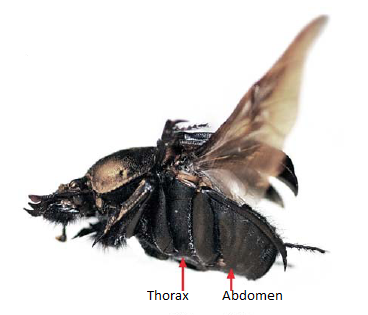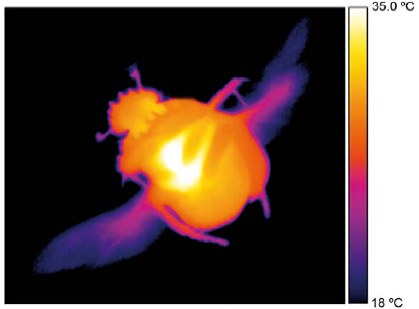
Adaptation
The
Scarabaeus sacer has achieved some remarkable things when referring
to adapting to its environment. One major component of its
adaption to the hot environment it lives in is how it moves. The
movement of the S. sacer
in the high temperatures focuses mainly on its flight and
movement of their dung. How they acquire and move their dung
back to their nest is unique and efficient. Their flight however
incorporates an internal heating and cooling system that
enhances their flight performance.
The S. sacers’
movement while forming their dung ball to bring to their nest is a
really interesting adaption. Depending on the type of dung they are
rolling depends on how they roll up their dung. If
it is a small piece of dung they use their middle or hind legs to
roll one or several pellets, and continually pulls pellets under it
to form a larger ball (Halffter
et al., 2011). If it is a
larger pile of dung they use their clypeus and forelegs to cut away
a piece of dung and push it under their body (Halffter
et al., 2011).
When the S. sacer is
moving their dung ball, its movement begins to be a rather unique
adaption depending on if there are partners or not. When they move
the dung ball individually they generally push the ball from behind.
They put their head down and its forelegs are supported on the ground,
while its middle and hind legs grasp the ball (Halffter
et al., 2011). When there
is a couple pushing the ball at the same time, the male takes the
pushing position behind the ball and the female gets in front of the
ball. She then pulls the ball with her middle and hind legs on the
ground and pulls the ball with her forelegs (Halffter
et. al.2011). 
One adaption that could be a little better in the
Scarabaeus sacer is their
thermoregulatory mechanisms that determine the heat in the organism.
Flying insects need to have high metabolic rates; this implies heat
loss and heat gain while flying (Verdú
et al., 2012). In the
S. sacer, the thorax is the
main heat generation centre and the thermoregulation is limited by
the abdomen because of its passive thermal window. (Verdú
et al., 2012). The passive
thermal window only allows so much heat out and can sometimes be
inefficient. This does not allow all of the heat out of the
S. sacer and if it flies
during the hotter part of the day it could over heat (Verdú
et al. 2012). The heat
transfer that occurs in the S.
sacer is facilitated by the hemolymph circulation system (Verdú
et al., 2012). Although these beetles may not be able to dissipate
heat as well as some other beetles, they are able to sequester heat
to a greater extent than other beetles (Verdú
et al., 2012). This could
be because of a greater development in the air sacs and a greater
percentage of volume in the tracheal system, in the
S. sacer (Verdú
et al., 2012). With the adaption of better air sacs and a larger
tracheal system the S. sacer
is a fairly large beetle, which may be able to help them push large
dung balls.
 The Scarabaeus sacers'
adaptations clearly revolve around its environment. Most of its
movement depends on the dung it collects. Likewise, its flight
depends on the temperature outside and distance it is going. Both of
these factors determine where the beetle will have its nest, how far
it will fly, and when it will fly.
The Scarabaeus sacers'
adaptations clearly revolve around its environment. Most of its
movement depends on the dung it collects. Likewise, its flight
depends on the temperature outside and distance it is going. Both of
these factors determine where the beetle will have its nest, how far
it will fly, and when it will fly.
C